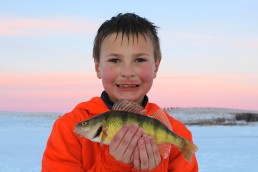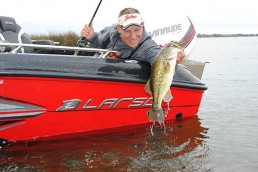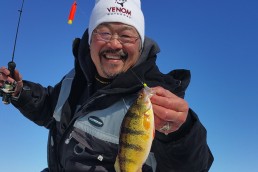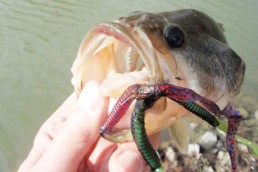Planning for Success
SHARE THIS POST
Everyone in the fishing industry says we should “take a kid fishing.” Public service announcements say it, pro anglers say it at the end of their TV shows, online videos and cool graphics in your favorite magazines tell you to take kids fishing, too. I’ll bet many of you are asking the same question that countless people have asked me over the years: “So, how do you take a kid fishing?”
It’s a good question.
In this edition of “Raising an Angler,” I will share with you the secrets I’ve learned for making ice fishing fun and addictive for kids.
Before we get into the plan that we use to take kids and new anglers out fishing, we need to define the word “success.” When we’re talking about kids and people new to the outdoors, this is our simple definition of success:
“Success is a positive outdoor experience.”
It doesn’t matter how many fish they catch, how big the fish are or what kind of fish they catch; what matters is that they have a positive outdoor experience.
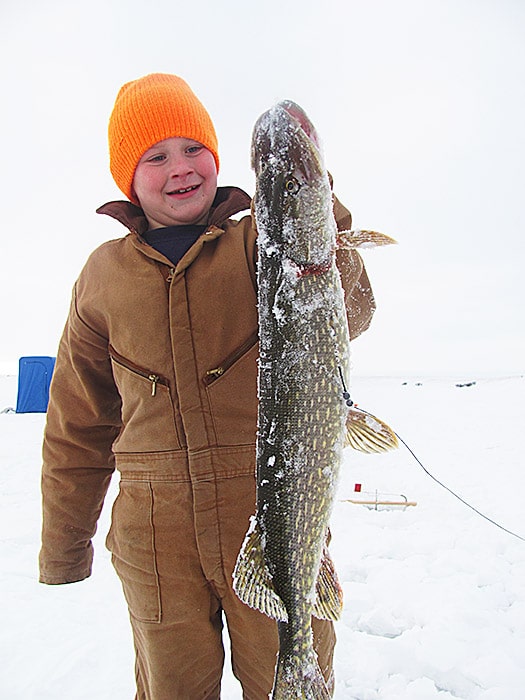
First you need a good plan
First you need to plan the trip. To do this you need to know your anglers, their attention spans, their capabilities and their limitations. (For more information on this, check out last month’s article “Know Your Angler,” in the “Raising an Angler” series.) Then pick a lake that fits your young anglers. Some of our favorite lakes for youngsters are passed over by other anglers because they don’t have big fish.
Selecting the right lake to take kids fishing
Take a good look at lakes that are full of stunted, 4- to 8-inch panfish. These lakes are great for young kids with shorter attention spans, because you often can catch fish one after another. Catching lots of small fish let’s you start teaching catch-and-release, too.
Next are small pike lakes. You can generally catch a lot of fish consistently in these, while also teaching kids some more advanced skills. These are great lakes for kids to learn basic jigging concepts while being able to catch fish, even if they’re not doing jigging quite right.
With kids that are ready for more, start looking for walleye lakes with a good evening bite and/or big pike lakes. These lakes provide the opportunity to stretch both skills and attention spans. One thing we like about big pike lakes is that they provide an opportunity for having a campfire and doing a little cooking and playing on the ice, along with the opportunity to catch a huge fish.
Don’t make a big deal out of the trip
Are you enjoying this post?
You can be among the first to get the latest info on where to go, what to use and how to use it!
Great expectations are what kill the fun in fishing. Not every trip goes as planned. If you don’t make a big deal out of the trip before you go, they won’t be disappointed if the trip doesn’t produce lots of fish or if the weather turns bad. I like to have a couple of options and pick the one that makes the most sense based on the weather and mood of the kids that day. You always want to have an alternate plan for bad days, too. My boys loved our “planned tackle making days” when the weather was too bad to venture out. They never knew the original plan was to fish that day. They just woke up and had fun in the shop with dad.
When you’re on the ice
Once out on the ice, give kids jobs to do so that they learn how to fish. Attach a wood handle to a skimmer (it’ll float) so they can skim holes and not worry about losing the skimmer. Tasks ranging from shoveling snow to carrying minnows are all good places to start.
Keep the jobs fun, and don’t make work out of something they might get into trouble for if they do it wrong. My rule of thumb is to only get firm with them on safety concerns, and always explain both why and the consequences to them in a calm, stern voice—and then stay positive and get back to fishing.
Have plenty of food and drinks. The rule is: never get cold; never get hungry. Warm, full kids have a lot of fun, energy and longer attention spans. Cold kids tell stories of how miserable and boring fishing is. So have plenty of food, warm drinks and a place to warm up. I have a lot of great memories of pike tip-up days, sitting in the pickup listening to college football on the radio with the boys.
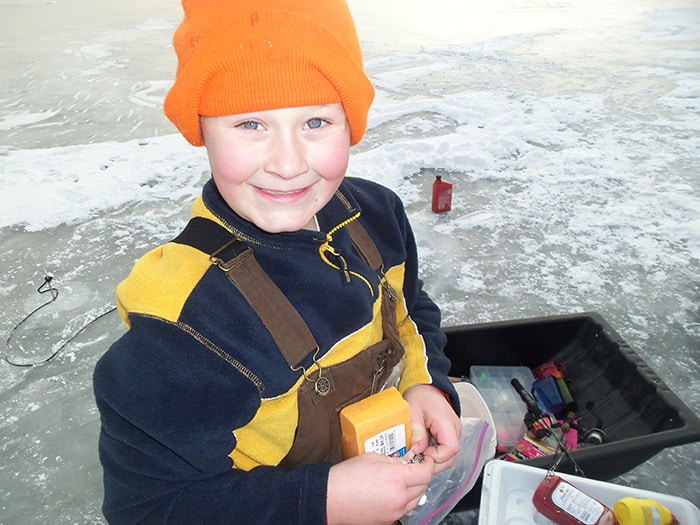
A Wing It slip bobber is invaluable when fishing with kids. With no effort, you can change bobber size to match the baits they are fishing. This bobber can easily be taken off and put back on if they choose a different way to fish. They can be used as slip or a spring bobbers, and are perfect tools for teaching kids how to jig, because they provide a reference point that kids can see. Even experienced anglers often forget that when a bait stops moving, or starts moving, it triggers fish to strike. Using a bobber to teach kids how to jig can automatically create both of these fish-biting triggers, which leads to the kids catching more fish.
Make sure you have plenty of warm and extra clothes. One of the rules we have on the ice is: don’t fall in a hole or get wet. Guess what? Kids occasionally do fall in holes and get wet, so this is not a rule to get mad about. It is a rule that may save their lives when they are older. Ice fishing as a kid on a frozen lake delivers a first-hand experience of how getting cold and wet can affect them. It also provides and opportunity for the kids to think ahead and plan how to be prepared if something happens.
Make sure you leave before they have had enough. When a kid says, “I’m done,” “I’m cold,” or “I’m bored,” it’s time to leave. But it is better to watch them throughout the day, and call it a day even before they say they are done. This is more important than you may think. Stopping while the memory is positive is crucial to having a positive outdoor experience—and making them want to come back for more.
Making memories
Don’t forget to take a lot of pictures of the trip. One of the keys to fostering a hunger for the outdoors in young and new anglers is giving them the tools to tell their story. Watching young and new anglers talk about everything that went into them catching the fish on the picture they show their friends and family is almost as much fun as seeing them catch the fish. Plus, this helps kids learn to express themselves and relate better to others.
Remember, it’s all about having fun so that they want to go again. I’ve been using this plan for over 30 years and tweaking it for every angler I take out, both on the ice and open water. It works. MWO
Geremy Olson is an avid outdoorsman, producer & public speaker, 241ink.org, whose son Peter also writes a monthly feature for MidWest Outdoors.
MWO
SHARE THIS POST
Did you enjoy this post?
You can be among the first to get the latest info on where to go, what to use and how to use it!
Geremy Olson
Geremy Olson grew up in the outdoors. After being burned as a volunteer firefighter, he had to figure out how to teach outdoor skills to his children from a wheelchair while learning to walk. Today he is an inspirational speaker, FCA Outdoors volunteer, tournament director, video producer, wildfire consultant and proud father of the owners of Missouri Secrets Tackle. GOspeaks.live.
